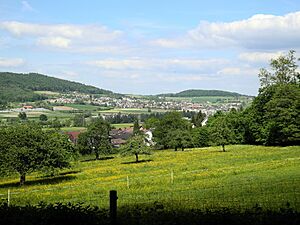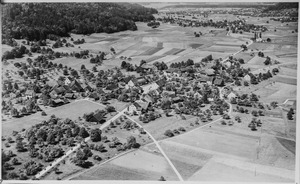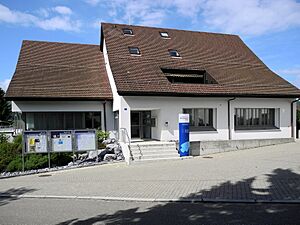Dänikon facts for kids
Quick facts for kids
Dänikon
|
||
|---|---|---|

Main street in Dänikon
|
||
|
||
| Country | Switzerland | |
| Canton | Zurich | |
| District | Dielsdorf | |
| Area | ||
| • Total | 2.87 km2 (1.11 sq mi) | |
| Elevation | 437 m (1,434 ft) | |
| Population
(Dec 2020 )
|
||
| • Total | 1,846 | |
| • Density | 643.2/km2 (1,666/sq mi) | |
| Postal code |
8114
|
|
| Surrounded by | Buchs, Dällikon, Hüttikon, Oetwil an der Limmat, Otelfingen | |
Dänikon is a small town, also called a municipality, in Switzerland. It is located in the Dielsdorf district, which is part of the canton of Zürich.
Contents
History of Dänikon
Dänikon was first mentioned in old writings in the year 1130. Back then, it was known by the name Täninchoven.
For a long time, until 1843, Dänikon was actually part of a nearby town called Dällikon. After that, it became its own separate municipality.
Geography of Dänikon
Dänikon covers an area of about 2.8 square kilometers (which is about 1.1 square miles). A big part of this land, about 53.6%, is used for farming. This means there are many fields and farms.
About 31.8% of the area is covered by forests, which are great for nature and exploring. The town itself, with its buildings and roads, takes up about 13.6% of the land. The rest, a small part (1.1%), includes things like rivers or mountains that aren't used for building or farming.
The town is located on the left side of a valley called Furttal.
People and Life in Dänikon
Today, about 1,846 people live in Dänikon. In 2007, about 24 out of every 100 people living there were from other countries. Over the last 10 years, the number of people living in Dänikon has grown a little.
Most people in Dänikon, about 87%, speak German. Italian is the second most common language, spoken by about 2.6% of the people. Turkish is the third most common, spoken by about 2.2%.
Age Groups in Dänikon
In Dänikon, about 28% of the people are kids and teenagers (from 0 to 19 years old). Most people, about 66%, are adults (from 20 to 64 years old). And about 6% are seniors (over 64 years old).
Education and Jobs
Many adults in Dänikon (about 76% of those aged 25-64) have finished high school or gone on to college. This shows that education is important in the town.
Only about 3 out of every 100 people looking for a job in Dänikon don't have one. This is called the unemployment rate.
Many people in Dänikon work in different types of jobs:
- Primary sector: About 68 people work in jobs like farming. There are about 10 businesses in this area.
- Secondary sector: About 235 people work in jobs like manufacturing or building things. There are 26 businesses in this area.
- Tertiary sector: About 121 people work in service jobs, like in shops, offices, or healthcare. There are 35 businesses in this area.
How Dänikon's Population Has Changed
The table below shows how the number of people living in Dänikon has changed over many years:
| year | population |
|---|---|
| 1467 | 7 Households |
| 1634 | 88 |
| 1799 | 173 |
| 1850 | 238 |
| 1900 | 192 |
| 1950 | 175 |
| 1970 | 373 |
| 2000 | 1,749 |
See also
 In Spanish: Dänikon para niños
In Spanish: Dänikon para niños







